- Home
- Bill Bryson
The Road to Little Dribbling Page 8
The Road to Little Dribbling Read online
Page 8
At the bottom of the hill I met two slightly plumpish young women who were peering up the shrubby slope as if they thought there might be bears up there. They both wore outfits of khaki shorts, T-shirts and trainers. Each carried a little rucksack.
‘Have you just come from the memorial?’ one asked me.
‘No, I was having a dump in the bushes,’ I wanted to say, but of course I didn’t. ‘Yes I have,’ I said. Her accent was American, so I tried to sound American, too. ‘It’s pretty neat,’ I said. It was the first time I had said ‘neat’ since seventh grade, and I quite enjoyed it.
‘Is it very far?’
‘Not very. But there are steps.’
A slight look of panic. ‘How many?’
‘I don’t know – maybe fifty or sixty.’
They looked at each other and had a conference. One decided to retire to the nearby tearoom; the other more bravely elected to go for it and set off up the hill. Within a few steps, she was making the sort of grunts female tennis players make at Wimbledon when serving for an important point. I listened to her progress for a few moments, then turned to bid farewell to her companion, but she had already dismissed me from her mind. She was wholly occupied with the challenge of getting across five hundred feet of open ground before she could enjoy the relief of a chair and a soft drink. I didn’t have the heart to tell her that the soft drink would almost certainly be small and served more or less at room temperature.
Runnymede, incidentally, is another thing that nearly didn’t survive. In 1918 plans were unveiled to cover the meadow with houses. Urban Broughton, a Briton who had made a fortune in America, bought it from its potential developer to save it. When Broughton died, his widow, an American, gave it to the nation. So one of your most historic sites remains pristine today because of the generosity of an American lady.
And with that patriotic thought in mind, I adjusted my rucksack and headed to Windsor.
Chapter 6
A Great Park
IN 1971, A SMALL, improbable chain of events was set in motion when the Department of Health in Britain sent posters to American institutions of higher learning that read: ‘Would you like to train to be a psychiatric nurse in England?’
Since the answer to that question was ‘Obviously no,’ the posters didn’t attract much attention. Most, I suspect, were discarded upon receipt. But one somehow made it on to a crowded bulletin board in a dormitory at the University of Iowa, where two friends of mine from Des Moines, Elsbeth ‘Buff’ Walton and Rhea Tegerstrom, saw it and, remarkably, very possibly uniquely, decided to respond. And so a few weeks later they were, rather startlingly, three thousand miles from home and proudly dressed in the sky-blue uniforms and starched white caps of student nurses at Holloway Sanatorium in Virginia Water, Surrey.
Large parts of my life are the result of decisive actions taken by others, but I have never been more indebted to anyone than to Buff and Rhea for their bold leap across the ocean, for it changed my life completely, too. If not for them, I would never have settled in England or met my wife and this book would probably be called My Forty Years in Peoria. God bless them both.
I was drawn into Buff and Rhea’s happy, eccentric orbit the following year when I stopped to see them at the end of a summer of hitchhiking around Europe. I was supposed to be on my way home to Des Moines, but during the course of an outstandingly convivial evening in the Barley Mow pub in Englefield Green, on the eastern edge of Windsor Great Park, they suggested that I should get a job at the hospital, too. Mental hospitals were always desperate for staff, they assured me. So the next day, I impetuously applied and to my mild astonishment was immediately accepted. It was rather like joining the army. I was sent to a basement storeroom where I was given two charcoal-grey suits, one thin black tie, two white shirts, three neatly folded white lab coats, some sheets and pillowcases, a set of keys and enough other items to form a stack in my arms that I could not see over. I was assigned a room in the male staff quarters and told to report to Tuke Ward. I was now an employee of the National Health Service, a resident of England, a sort of grown-up and a full-time foreigner – four things I hadn’t expected to be just twenty-four hours before. Not long after that I met a jolly decent student nurse named Cynthia, and found myself falling for her and falling for England simultaneously. Forty years later, I am still with them both.
So this was the part of the world where my English life began. I hadn’t been back to the area for some years, and was eager to spend a day strolling through my former life. So, early on yet another bright summery morning – the weather was being most un-Englishly kind – I set off from my hotel in Windsor and found my way through the still-quiet streets of the town to the broad, processional route known as the Long Walk, leading from the town into Windsor Great Park and to the world of my past just beyond.
Windsor Great Park is a remnant of the ancient Windsor Forest and part of the royal estate. It is a little land of enchantment, like the set of a fairy tale, a rolling, timeless realm of woods and farms and the picturesque cottages of estate workers, charmingly threaded with wandering lanes that are largely free of traffic. (Only those with business on the estate are allowed to use them.) It has a lake, enormous lawns for polo, scattered statues and other ornaments, herds of grazing deer, and occasional walled enclosures beyond which are royal retreats, like the Royal Lodge, where the Queen lived as a girl. It is forty square miles of invigorating glory on the very edge of London, yet relatively few people visit it and hardly any plunge into its bosky interior.
The Long Walk ends with a slow climb to the summit of Snow Hill, where there is a giant equestrian statue of King George III and panoramic views of Windsor Castle and all the countryside around. Henry VIII, it is often said, rode up to this point to listen for the cannons of London announcing the execution of Anne Boleyn. Everything was lovely except the sky. Planes wheeled just overhead, dragging shadows over the earth, as they prepared to land at Heathrow, five miles off to the east. They were low enough that I could read the serial numbers on their undersides and very loud – louder even than at Wraysbury because Windsor is directly on a flight path. Goodness knows what it will be like for the people west of London if Heathrow gets a third runway. Already nearly half a million flights a year come and go at Heathrow. A third runway would increase that to 740,000. At what point do people decide that enough is enough?
I think we are there already. Just consider for a moment the last time you booked a flight from London to New York or Paris or Melbourne. You had lots of choice, did you not? I mean lots of choice – of airlines, times of departure, times of return. Do you need 50 per cent more choices than that? The argument is that if Heathrow doesn’t expand other European airports will steal its business. Charles de Gaulle airport, it is pointed out, handles ten million fewer passengers a year than Heathrow, but has four runways to Heathrow’s two. Amsterdam has 20 million fewer passengers but six runways. If Heathrow doesn’t build new runways, the argument goes, it will stop being able to compete. The question that occurs to me is then why hasn’t that happened already?
I’ll tell you what you will actually get with another runway. You will get more takeoffs and landings, but in smaller planes. That’s what’s happened in America. There used to be four or five flights a day between Chicago and Denver or St Louis or Minneapolis, all on regular-sized planes. Now you may get a dozen flights a day, perhaps even more, but in tiny regional jets seating thirty people with their knees jammed up against their faces. So you have more choice but a much poorer service. With small planes, for one thing, it is much easier to cancel undersold flights and put everyone on the next plane.
Do you know, incidentally, why Heathrow was built where it is? After the war the task of choosing a location for a new London airport was given to Alfred Critchley, a Canadian-born businessman who had made a fortune first by promoting greyhound racing and then by getting into cement in a big way, so to speak. He consolidated a whole bunch of small cement makers into t
he mighty enterprise known as Blue Circle and became hugely wealthy in the process. During the war, Critchley helped to set up training programmes for flyers, and because he knew a little about aviation and a great deal about the pouring of cement he was given the job after the war of deciding where to build a new airport to replace the old aerodrome at Croydon. I had always assumed that Heathrow was selected for some important practical reason – the porosity of the subsoil or depth of the water table or something – but in fact Critchley chose it because it was halfway between his house in Sunningdale and his office in London.
Critchley died in 1963 before Heathrow became the colossus it is now, so he had no idea what he was inflicting on the world. The Heathrow he last saw was still a place of pleasure and excitement. I happen to own three packets of Viewmaster discs of Heathrow from that period and they are a marvel to behold, for they show that Heathrow in those days had about sixteen aeroplanes and a few dozen well-dressed customers. One man with an excellent moustache seemed to run the control tower all by himself. The terminals were sleek, modern and practically empty. Everyone involved in the check-in process was immensely happy. Aboard the planes, everyone was happier still. The stewardesses, it appears, not only served you a large tray of food, but stood smilingly by your seat and watched you eat it.
What a wonderful world that was, and how remote it seems now. It is a challenge to believe that there was ever a time that airline food was exciting, when stewardesses were happy to see you, when flying was such an occasion that you wore your finest clothes. I grew up in a world in which everything was like that: shopping malls, TV dinners, TV itself, supermarkets, freeways, air conditioning, drive-in movies, 3D movies, transistor radios, backyard barbecues, air travel for all – they were all brand new and marvellously exciting. It is amazing we didn’t choke to death on all the novelty and wonder in our lives. I remember once my father brought home a device that you plugged in and, with an enormous amount of noise, it turned ice cubes into shaved ice, and we got excited about that. We were idiots really, but awfully happy, too.
I had an enjoyable, meandering amble across the park and exited at a spot called Bishop’s Gate, where I joined a network of wooded back lanes leading to Englefield Green. The broad green for which the village is named is by far its finest feature. It is, I suppose, three or four acres in size, and lined on every side with big houses. At its southern end stands the Barley Mow pub, smaller than I remembered, but still handsome. It occurred to me with a shiver that it must be nearly forty years since I was last in it. It was too early for it to be open, but I peered through the windows and was glad to see that it hadn’t changed in any alarming way. Across the green, visible above a fringe of billowy hedges, was a large house that Buff’s boyfriend Ben pointed out to me once as the home of Leslie Charteris, creator of the Saint detective stories. This impressed me deeply. In Iowa, we were not used to seeing the houses of well-known people on account of there were no well-known people in Iowa.
I can’t say I was a fan of Leslie Charteris myself or even knew a single thing about him, but each month my mother bought a Saint magazine for twenty-five cents at the supermarket and read the stories avidly, which was recommendation enough for me. This man was not only a famous author, he was a magazine. Whenever I passed the house after that, I always dawdled in the hope of glimpsing the elusive Charteris, but I never did. I imagined him to be a suave Englishman, like the Simon Templar character he created for his stories. In fact, I later learned, he was half Chinese, born Leslie Yin in Singapore in 1909. So even if I had seen him, I would probably have thought he was Charteris’s herbalist or something. I had no way of knowing it at the time, but Charteris was a recluse and a bigot. Though he was at the height of his fame thanks to a television series starring Roger Moore, he had long since given up writing his own books, but left it to ghostwriters. (A practice that is more common than you might think. This one’s been written by Andy McNab.)
Away from the green, Englefield Green village was never very pretty and now seems to have given up trying. It used to have banks and butchers and greengrocers, but those are mostly gone now and instead there are coffee shops and little restaurants and an inordinate number of wheelie bins outside every property. Goodness knows what they get up to there, but it sure generates a lot of waste.
Beyond the village, standing along the busy A30 at the top of Egham Hill, is the campus of Royal Holloway College, an outpost of the University of London. The college began as a single vast building, a kind of English Versailles set down on a patch of high ground in the outermost suburbs of London, and was the philanthropic gift of a patent medicine manufacturer named Thomas Holloway. Holloway College was one of the grandest buildings built anywhere on the planet in the nineteenth century and it still staggers on first sight. It is five hundred feet long across the front, a third of a mile around. It contains 858 rooms and embraces two spacious courtyards. But where Versailles was made for kings, Holloway College more nobly was built as a women’s college, at a time when women’s colleges were a rarity. Why Thomas Holloway and his wife Jane decided to sink much of their wealth into a college for women isn’t known, any more than it is known why they decided to fund a companion building, Holloway Sanatorium, to house well-off deranged people, two and a half miles away in the village of Virginia Water.
Both were designed by an architect named William Henry Crossland, who produced these two colossal buildings and then fell into a curious professional inertia. Though he lived another twenty-two years, Crossland never did another thing. Instead he took up with an actress eighteen years his junior named Eliza Ruth Hatt, and with her produced a second family while still remaining attached to the first, living some of the time with his wife and daughter in one house and some of the time with Hatt and the children she bore him in another. The effort of it all exhausted his body and his resources, and ultimately the patience of both his wife and mistress, for he died alone and destitute in cheap lodgings in London in 1908.
Which surely proves something.
I strolled on to Virginia Water along Bakeham Lane, which in the whimsical fashion of English roads changes its name to Callow Hill about halfway along. The road was rather busier than it had once been, and a good deal more littered around the edges, but otherwise was still leafy and pleasant. It is amazing how much you absorb and evidently hold on to for ever on a route you have commonly walked, for I felt I remembered nearly everything – the curve of driveways, the pitch of house roofs, the knockers on front doors. It was extraordinary to recall so vividly things I hadn’t thought about in decades, particularly when you consider that I can’t remember what I had for breakfast or the names of anyone I haven’t spent at least an hour with in the last two weeks.
At length I came to Christchurch Road, the straight and stately avenue leading into the village of Virginia Water. Once this was the loveliest road I could imagine, lined on both sides for a mile or so with dark and jaunty houses in a rambling arts and crafts style, each one a happy jumble of gables, porches and jostling chimney pots, each standing in its own paradise of luxuriant shrubs and tumbling roses. It was, as I said in Notes from a Small Island, like stepping into the pages of a 1937 copy of House Beautiful magazine. Those houses are nearly all gone now, bought for a fortune only to be torn down and replaced by much larger homes in a style that might be called Russian Gangster.
The village centre is much changed, too. Nearly all that I remember fondly is gone. The Tudor Rose, the world’s most endearingly terrible restaurant, where all the food was black or dark brown, except the peas, which were a pale grey, has long since departed and is much missed by me, if no one else. The fishmonger, travel agent and greengrocer are all gone, too. One of them – I don’t remember which – had a royal warrant from the Queen Mother, which always impressed me. Barclays, the only bank in the village, had just permanently closed. A sign on the door invited us to go to Chertsey for our banking needs. Even more tragically vanished was the bookshop owned by the writer
, actor and film director Bryan Forbes. It was the perfect bookshop. I spent hours in there; read whole books in there. Every once in a while you would see Bryan Forbes himself, and that was always a thrilling moment for me, a boy from Iowa. Once I saw him talking to Frank Muir and almost fainted from the excitement.
The bookshop was also the scene of my most outstanding moment of manliness in life. I happened to be browsing there one day when a patient from the sanatorium whom I’ll call Arthur came in. Arthur was middle-aged and unexpectedly distinguished-looking. Like many of the patients at the sanatorium, he came from a privileged background (the hospital had been private until the late 1940s) and he dressed quite well in the tweedy style of a country gentleman. You would never have taken him for a madman. But he had one quirk that kept him permanently institutionalized. He could not abide being spoken to by strangers. If someone merely smiled and said good day, Arthur would explode in froth and fury and pour forth a tumult of startlingly original insult. Everyone in the village knew this, so no one disturbed him on his daily rounds. It happened, however, that on this day the bookshop was in the care of a sweet, newly employed young woman who had no idea of Arthur’s peculiarities, and asked him if she could help him find anything.
Arthur turned on her more in amazement than anger. It had been years since anyone had addressed him in a public place.
‘HOW DARE YOU SPEAK TO ME, YOU SLUTTISH BITCH,’ he hissed, swiftly warming to the task. ‘DON’T YOU COME ANYWHERE NEAR ME, YOU PUSTULANT, SPREAD-EAGLED DAUGHTER OF SATAN.’ Arthur was nothing if not expressive when roused. The young woman stared at him with a look I had only ever seen on a female face in horror movies in the moment between a shower curtain being yanked open and a dagger coming down.
I stepped up and in a sharp tone said: ‘Arthur, put the book down and leave at once.’

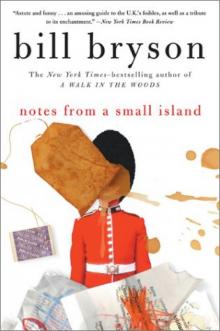 Notes from a Small Island
Notes from a Small Island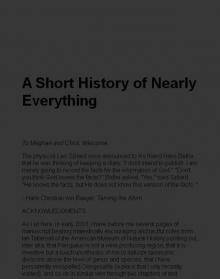 A Short History of Nearly Everything
A Short History of Nearly Everything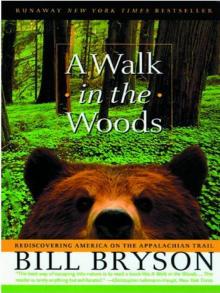 A Walk in the Woods
A Walk in the Woods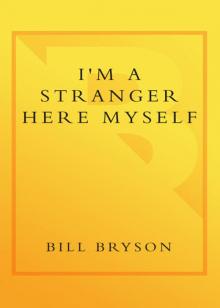 I'm a Stranger Here Myself
I'm a Stranger Here Myself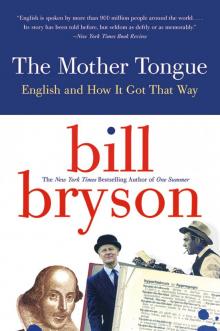 The Mother Tongue
The Mother Tongue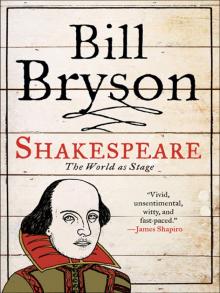 Shakespeare
Shakespeare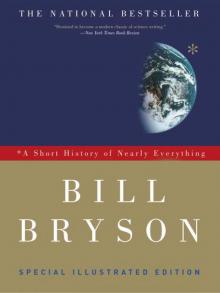 A Short History of Nearly Everything: Special Illustrated Edition
A Short History of Nearly Everything: Special Illustrated Edition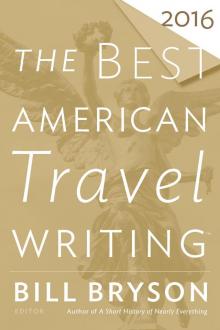 The Best American Travel Writing 2016
The Best American Travel Writing 2016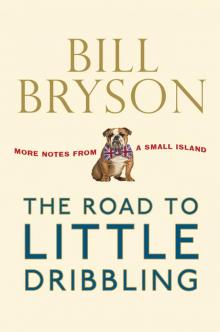 The Road to Little Dribbling
The Road to Little Dribbling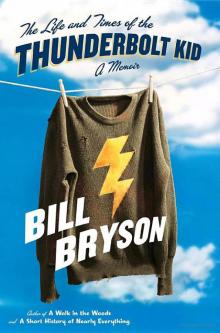 The Life And Times Of The Thunderbolt Kid: A Memoir (v5.0)
The Life And Times Of The Thunderbolt Kid: A Memoir (v5.0) Made In America
Made In America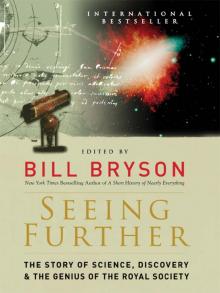 Seeing Further
Seeing Further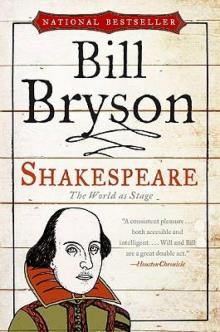 Shakespeare: The World as Stage
Shakespeare: The World as Stage The Life and Times of the Thunderbolt Kid
The Life and Times of the Thunderbolt Kid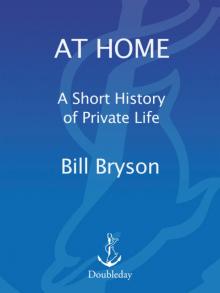 At Home
At Home Bryson's Dictionary For Writers And Editors (v5.0)
Bryson's Dictionary For Writers And Editors (v5.0) Neither Here Nor There
Neither Here Nor There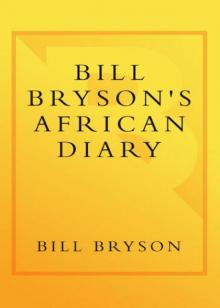 Bill Bryson's African Diary
Bill Bryson's African Diary